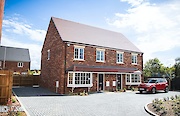


Content Writer

Mortgage Advisor & Director

If you own or rent a flat, you might wonder whether you need a particular home insurance policy. The good news is, most home insurance providers’ policies cover flats, as well as houses and other property types.
We look at the type of home insurance policies available for flats, what providers will look at when assessing your home, and how to get the best policy for your needs.
Are there specific home insurance policies for flats?
Not really, no. You’ll typically have buildings, contents, or combined buildings and contents home insurance policies available to you. However, not all insurers cover all types of flats, so you may need a specialist insurance provider. It can, therefore, be wise to use a broker to find providers that cover the specific type of flat and ownership basis that applies to you.
If you own or plan to own your flat on a freehold basis, you will likely need to arrange both building and contents insurance cover. As the majority of flats tend to be leasehold, however, you may only need to take out contents insurance.
With contents insurance, the premiums are based on the value of your possessions, and you can usually choose different levels of cover depending on what suits you best. This might include covering your possessions against theft, or both theft and accidental damage.
How providers assess flat insurance applications
Similarly to houses, flats are assessed based on their construction and security when it comes to home insurance. This might include factors like the location and local crime statistics, as well as the building materials and building type.
Buildings insurance
This element of home insurance is typically assessed based on the rebuild cost of the property. This can be a bit more complex with flats, as property damage may impact multiple residences at a time, most insurers will consider:
-
Construction and materials - this will be considered in terms of both their resilience and their availability, should they need to be replaced
-
Property type - non-standard construction properties, which many flats are classified as, due to many having a flat roof covering more than 25% of the property
-
Property age - older homes, and particularly homes built in certain periods, are known to be less robust, which can mean they are higher risk
-
Location - the environmental risks surrounding your property, such as whether you’re near a flood zone or an area known for subsidence, will be a factor for all insurers
Contents insurance
This is based on the value of your possessions, as well as the security of your home. Similar considerations will be made as for buildings insurance, however, there is likely to be greater focus on location, whether there are multiple entrances, whether there is a shared entrance, the types of locks used, as well as whether your property is permanently occupied
While higher risk elements may make it more difficult to cover certain flats, it’s unlikely your flat would be uninsurable. However, the greater the risk of property damage, or in the case of contents insurance, theft, the higher their premiums are likely to be.
Getting cover for a leasehold flat
If you own your flat on a leasehold basis, or rent it, you won’t often need to arrange the building element of home insurance, as this tends to be the freeholder’s responsibility - although the premiums are likely covered by your service charges if you pay them. Keep in mind, however, that mortgage lenders may want to see evidence of leaseholder insurance when you take out a mortgage on a flat, so you’ll need to obtain a copy if someone else arranges your building insurance.
Can you get home insurance on a block of flats?
In some cases, where you jointly own the freehold with other residents, it may be your joint responsibility to organise building cover for the block of flats. Taking out one policy for the block can prevent any issues if there is damage to multiple flats, as it could become complex to repair damage if different residents are covered on a different insurance basis.
This type of building insurance should also ideally include cover for communal areas used by all residents, such as:
-
Foyers and corridors
-
Communal gardens
-
Unoccupied flats
-
Employer’s liability where needed - for example, for cleaning or gardening staff, etc.
Remember that no matter who organises your buildings insurance, you’ll need to take out contents insurance to cover your possessions independently.
Get a home insurance quotes comparison online
You can compare home insurance quotes online on a wide range of comparison sites; but, most only include options to cover brick-built houses. Those with a more complex construction, like flats, listed buildings and prefab houses usually need specialist insurers.
It can be helpful to get guidance from a broker with experience in organising home insurance for flats, as they will know which providers are likely to accept your property, whether you’re looking for buildings insurance, contents insurance, or full buildings and contents home insurance cover.

Get bespoke advice on your home insurance
Which insurers offer specialist policies for flats?
Here are some examples of insurers that provide insurance cover on flats, however, keep in mind that not all specialist insurers will be easy to compare. To get a full view of the policies available to you it’s a good idea to speak to a specialist broker, like ourselves:
-
AXA will consider properties with flat roofs, so this may be suitable for those in tower block or maisonette style properties with a predominantly flat roof.
-
Aviva also considers a range of non-standard properties, such as blocks of flats and houses split into flats with a shared entrance
-
Lansdown offers specific cover for those who own blocks of flats, whether that’s as a landlord or a group of tenants
Why choose Teito for your home insurance needs?
It can be more difficult to secure an insurance policy for a flat or block of flats, especially if you’re looking for buildings as well as contents cover. Many specialist insurers in this niche require manual underwriting, which usually requires expert guidance.
At Teito, we provide home insurance for flat owners every day, so we understand the challenges of insuring this type of home. We can also compare products from across the market to ensure you’re getting the most competitive premiums available for your home.
Others came to us for our support in securing flat insurance because:
-
We have specialist knowledge in this type of insurance and can offer bespoke quotes
-
We are 5-star rated across leading review platforms such as TrustPilot and Google
-
Your first consultation is free, with no obligation to proceed
Ready for a free, no-obligation chat with an adviser specialising in home insurance for flats? Get started here.
FAQs
Premiums can be higher on flat insurance, due to factors outside of your control that increase the risk to insurers, such as flat roofs or a shared entrance. However, there are some things you can do to mitigate some of the risks, which could play a role in bringing down your insurance premiums:
-
Make improvements to your home security, such as alarms, additional or better quality locks, and security cameras
-
Opting to pay a larger excess can reduce premiums
-
Having a combined buildings and contents policy (where possible) can be helpful
-
Paying an annual fee, rather than monthly premiums, can sometimes qualify for a discount
-
Getting advice from an experienced broker when comparing policies can help prevent you from overpaying
Choosing an Adviser
Selecting a qualified and experienced mortgage adviser is of great importance. To choose a suitable adviser, evaluate their qualifications, experience, and reputation, and ensure they are regulated by the Financial Conduct Authority (FCA).
Read reviews from previous clients and make sure they provide a clear explanation of the products and services they offer, as well as the fees and charges associated with them.





















































































































































